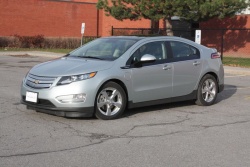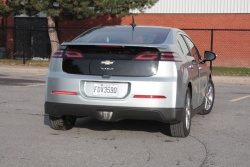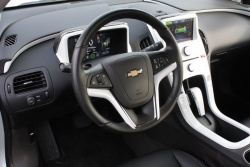 2012 Chevrolet Volt. Click image to enlarge |
| More Chevrolet Volt reviews on Autos.ca
Manufacturer’s web site |
By Chris Chase and Paul Williams; photos by Chris Chase
Photo Gallery:
2012 Chevrolet Volt
Ladies and gentlemen, we’d like to introduce you to the beginning of the end of gas-electric hybrid passenger vehicles as we know them. The 2012 Chevrolet Volt is something of a marvel on the road. There’s no other car quite like it, and General Motors is to be congratulated for moving from concept to reality in double-quick time. After receiving numerous awards and accolades, as GM says, “the Volt is in a class by itself.”
It’s not a hybrid, says the company, because its driven wheels are always powered by electricity. But you have to hang on tight to this position because the Volt certainly uses a combination of gasoline and electricity as fuel, via a gasoline engine and electric motor for motive power. From our perspective, a hybrid, by definition, is just this type of combination.
GM’s take is that the Volt is both a plug-in hybrid vehicle (PHEV) and electric vehicle (EV). It’s pushing for “Electric Vehicle with Extended Range” (EVER?). Chevrolet calls this method of propulsion the Voltec system.
But labels aside, the Volt certainly can run for usable distances on electricity alone, after you’ve charged its 400-pound lithium-ion battery. If you exceed the battery’s charge, the system switches seamlessly to gasoline as its source of energy, operating pretty much as a “normal” hybrid, except that unlike the Toyota Prius, for example, the wheels are never driven directly by the gasoline engine.
We’ve have heard the Nissan Leaf described as the best new vehicle your money can buy, period. The journalist who expressed that opinion is right, in the sense that it breaks ground and sets the market up for more electric vehicle (EV) competition. That, in turn, will lead to improvements in the technology, bring prices down, and make EVs more accessible to all (again, more on that later).
  2012 Chevrolet Volt. Click image to enlarge |
But in terms of current-day personal transportation, the Leaf’s only flaw is its 160-kilometre range, which limits it to city driving. That’s not a bad thing, necessarily, but a driver who needs a vehicle for highway trips will need to either own a second car (which many families do) or rent one as needs dictate. The Volt’s advantage is that its gas engine allows the car to be operated outside of the typical EV envelope: battery runs out, gas engine starts, car keeps going until it’s time to fill the tank. That makes it feasible for single-vehicle households who want a car suitable for all situations, not just the commute to work or trips to the mall. What the Volt does is admit the shortcomings of current electric vehicle technology and public charging infrastructure while allowing early adopters the chance to get into an EV that works around those limitations. Call the Leaf a “pure” electric vehicle, while the Volt simply incorporates EV technology.
We were scheduled to head out of town the day after we received the Volt, on a journey that would cover about 400 km, and were interested to see just how the car performs on a long trip, the type of which is quite common in North America.
Starting the car is achieved by pressing a blue button on the centre console, which brings the Volt to life with a wonderful sound that reminded us of Star Trek, warp drives, and a beaming Scotty the engineer — wrench in one hand, tricorder in the other.
Then, nothing: not a peep unless the radio is on. Selecting “Drive” is done with a familiar gearshift lever, but this is something of a carryover from non-electric cars, as this car doesn’t use gears in the conventional sense. It uses a planetary gearset, three clutches, two electric motors (primary and secondary) and one gasoline engine. But selecting “Drive” is all you really need to know.
Once underway, the Volt continues its super-quiet operation, with no noise coming from the drivetrain at all. There is noise from the tires as they move over the road, and of course some outside noise is noticeable as well. But basically, the sensation is of smoothness and efficiency.











